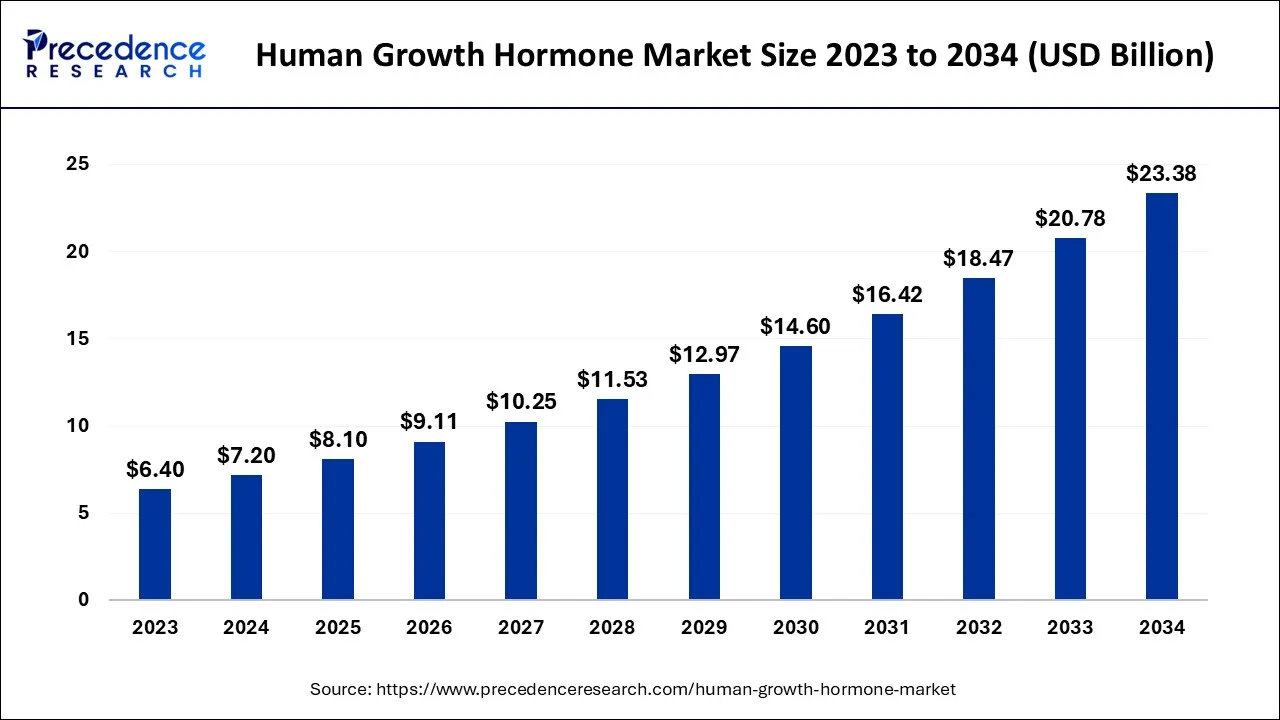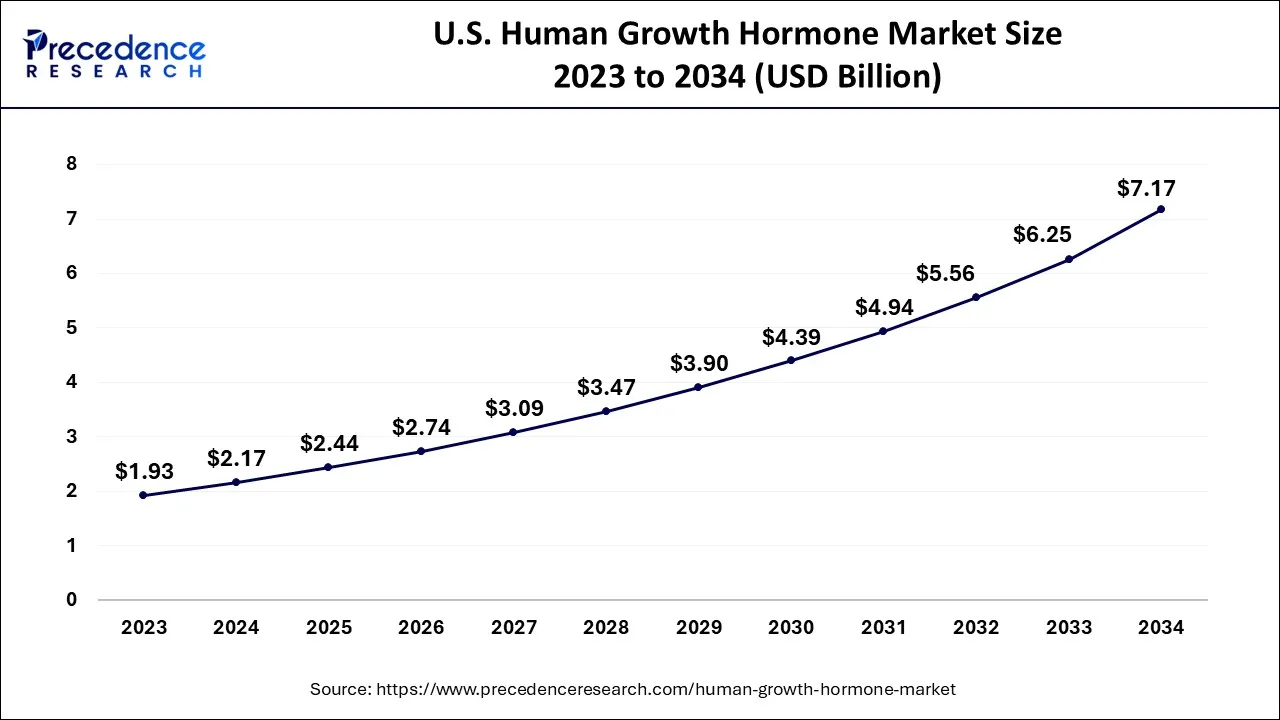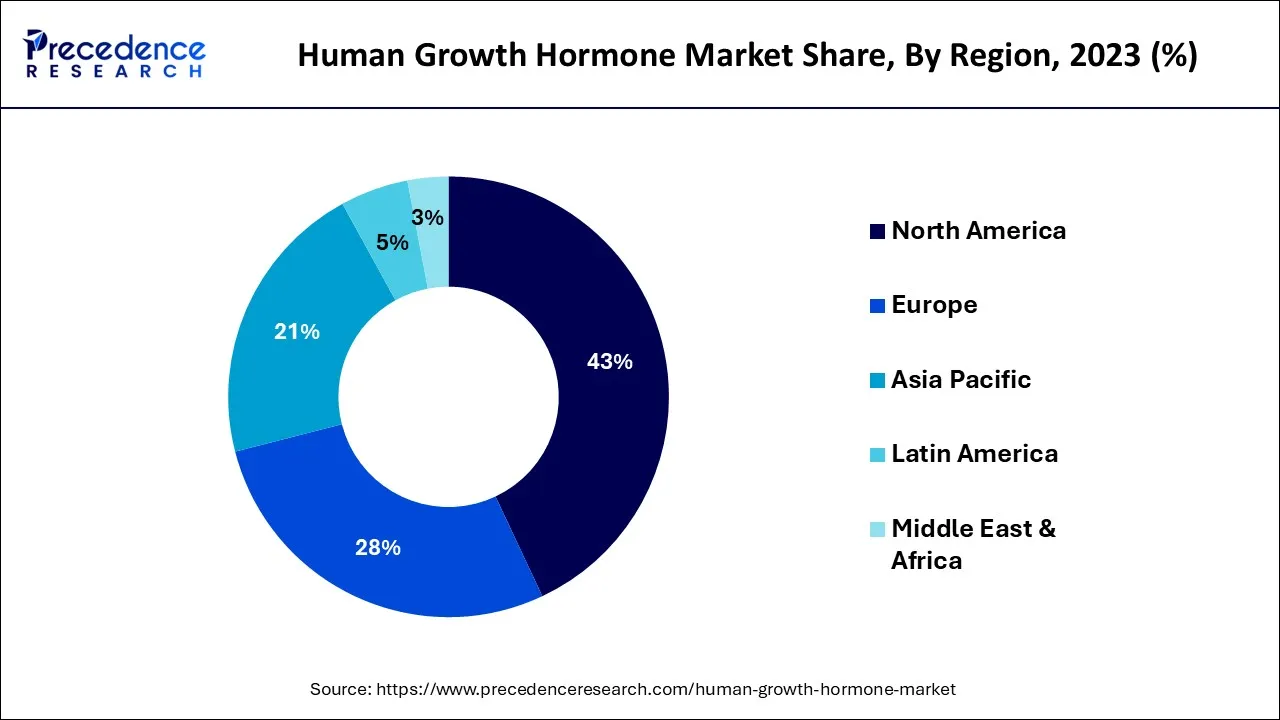December 2024
The global human growth hormone market size accounted for USD 7.20 billion in 2024, grew to USD 8.10 billion in 2025 and is expected to be worth around USD 23.38 billion by 2034, registering a CAGR of 12.5% between 2024 and 2034. The North America human growth hormone market size is calculated at USD 3.10 billion in 2024 and is estimated to grow at a CAGR of 12.63% during the forecast period.
The global human growth hormone market size is calculated at USD 7.20 billion in 2024 and is projected to surpass around USD 23.38 billion by 2034, growing at a CAGR of 12.5% from 2024 to 2034.

The U.S. human growth hormone market size is exhibited at USD 2.17 billion in 2024 and is projected to be worth around USD 7.17 billion by 2034, growing at a CAGR of 12.71% from 2024 to 2034.

North America is expected to account for the highest share due to variables such as favorable reimbursement scenarios, established healthcare infrastructure, considerable government initiatives, and expanding healthcare awareness. Furthermore, increasing access to innovative pharmaceuticals as a result of the presence of important firms in the region benefits the North American market. Pfizer, Inc., Eli Lilly and Company, and Genentech, Inc. are three significant players located in the United States that provide a diverse variety of human GH medicines in the region.

Over the projection period, Asia Pacific is expected to grow at a rapid pace. Key competitors are focusing on attaining a significant market share in prospective Asia Pacific nations such as Japan and China through product approval and launch. For example, in March 2017, Novo Nordisk A/S, a Danish pharmaceutical firm, began a phase III clinical study in Japan for their HGH somapacitan, which is designed for the treatment of adult growth hormone insufficiency.
Technological advancements in China and the growing disposable income will play a significant role in the growth of the Asia Pacific market. Advancements in the research and development to an increased consumption of human growth hormones in Japan. Many investments are made by the government in various nations of the Asia Pacific region and this is expected to fuel the market growth in the long run. Prevalence of genetic diseases in the Asia Pacific region will have a significant impact on the growth of this market. Short term treatment for various disorders with the help of human growth hormone in the European nations will support this market. Government expenses made on treating such diseases will have a positive impact on the market growth. Germany is the leading market of human growth hormone in the European region
Market Overview
The pituitary gland produces human growth hormone which induces growth in adults and in children and this is a peptide hormone which does the work of regeneration, reproduction, repair and cell metabolism. This hormone primarily engages in regulating growth. Fat metabolism and body fluid regulation is other functions of human growth hormones. They also help in the growth of muscles and bones. Fat accumulation is caused due to the deficiency of this hormone. It also leads to various diseases which may cause short bowel syndrome, muscle wasting, acromegaly and gigantism. The prevalence of chromosomal disease which is Turner’s disease or Turner syndrome, is due to the deficiency of growth hormones. Increasing awareness among the consumers about the health benefits associated with the consumption of human growth hormone drugs is expected to drive the market in the long run. It also aids in the improvement of muscular strength and performance.
The COVID-19 epidemic is expected to have an effect on the worldwide human growth hormone market. According to a Frontiers article, patients with low growth hormone production are at risk for COVID-19, which requires attention to aid in COVID-19 prevention. Patients suffering from Prader-Willi syndrome must also take precautions. Turner syndrome patients are at an increased risk of serious disease from the COVID-19 virus.
A growth hormone deficiency occurs in humans when the pituitary gland does not have an appropriate concentration of human growth hormone. This deficiency is addressed by injecting human growth hormone subcutaneously. Growth hormone deficiency can also be caused by genetic illnesses such as Prader-Willi syndrome and Turner syndrome, resulting in delayed puberty and lower height than usual.
A growth hormone shortage develops in humans when the pituitary gland does not produce enough human growth hormone. Human growth hormone is subcutaneously injected to treat this deficit. Genetic diseases such as Prader-Willi syndrome and Turner syndrome can also induce growth hormone deficit, resulting in delayed puberty and shorter height than typical.
Furthermore, several firms are investing in R&D to create a growth hormone with fewer side effects and that will be a long-term therapy. The expansion of the market can be associated with the increasing cases of disorders caused by the deficiency of this hormone. Constant efforts made by governments and other private groups to raise awareness of growth hormone deficiency and high productivity. Other reasons such as enhanced treatment awareness, and growing g cases of numerous health conditions like the neuropsychiatric conditions will create more demand for Human Growth Hormone drugs and favour market growth. The quick development of new human growth hormone molecules is projected to fuel the growth of the human growth hormone market.
The public's knowledge of the usage of synthetic growth hormone treatment has gradually improved over time. However, increased industry research into the causes of growth abnormalities, as well as an increase in diagnosis, has resulted in increased market growth. Among these conditions are paediatric growth hormone insufficiency, idiopathic short height, adult growth hormone deficiency, and inherited disorders such as Turner syndrome and Prader-Willi syndrome. One in every 3800 children worldwide has a growth hormone deficiency. Turner syndrome affects around one in every 2000 females, while Prader-Willi syndrome affects approximately one in every 30,000 people.
| Report Coverage | Details |
| Market Size in 2024 | USD 7.20 Billion |
| Market Size by 2034 | USD 23.38 Billion |
| Growth Rate from 2024 to 2034 | CAGR of 12.5% |
| Fastest Growing Region | Asia-Pacific |
| Largest Market | North America |
| Base Year | 2023 |
| Forecast Period | 2024 to 2034 |
| Segments Covered | By Application, By Distribution Channel |
| Regions Covered | North America, Europe, Asia-Pacific, Latin America and Middle East & Africa |
Steady Growth in Industries
Increasing R and D initiatives
Adverse effects of synthetic growth hormones
The growing number of hospital pharmacies will provide considerable market expansion potential
The GH deficiency category had the biggest market share in 2023 and is likely to maintain its dominance throughout the forecast period. This is due to increased awareness regarding the early detection and treatment of GH insufficiency in people, as well as the introduction of innovative medications into the hGH market. For example, Ascendis Pharma A/S gained Orphan Designation from the European Commission (EC) in October 2018 for its experimental long-acting GH medication for humans, TransCon hGH, which is recommended for the treatment of paediatric GH deficiency.
Similarly, Ferring Pharmaceuticals Inc. got USFDA clearance in January 2018 for its novel recombinant HGH, Zomacton (somatropin), which is approved for the treatment of adults with GH insufficiency. The GH deficiency sector is further subdivided into adult GH deficiency and paediatric GH deficiency, with the latter expected to dominate the market throughout the projection period due to a rising number of pipeline medications. For example, in October 2019, Pfizer Inc. and its partner OPKO Health Inc. stated that their Phase III research of Somatrogon in pre-pubertal children with hGH fulfilled its primary goal of non-inferiority to daily somatropin.
Turner's syndrome accounted for the second-largest market share in 2023 and is expected to emerge as a profitable category during the projected period. This might be linked to increased efforts by different public and private groups to raise awareness about Turner syndrome early diagnosis and treatment. Every year in February, non-profit groups such as Turner Syndrome Support Society (UK), Turner Syndrome Society of the United States, and Turner Syndrome Foundation observe "Turner Syndrome Awareness Month"; and undertake a worldwide campaign to raise awareness of the illness.
The human growth hormone market has been classified into hospital pharmacy, retail pharmacy, internet pharmacy, and specialty pharmacy. In 2023, the hospital pharmacy category had a sizable market share. This large percentage can be ascribed to an increase in hospital visits as people become more aware of GH insufficiency and its treatment. According to the Children's Hospital of Philadelphia (CHOP), prescriptions for growth hormone have climbed from 5.1 patients per 10,000 enrollees in 2001 to 14.6 patients per 10,000 in 2016.
Because of the increasing prevalence of pharmacies in developed nations such as North America and Europe, the online pharmacy segment is likely to grow at a considerable CAGR over the forecast period. Furthermore, the growing popularity of online pharmacies in emerging markets such as India and China is likely to propel category expansion in the future years.
By Application
By Distribution Channel
By Geography
For inquiries regarding discounts, bulk purchases, or customization requests, please contact us at sales@precedenceresearch.com
No cookie-cutter, only authentic analysis – take the 1st step to become a Precedence Research client
December 2024
October 2024
November 2024
March 2025